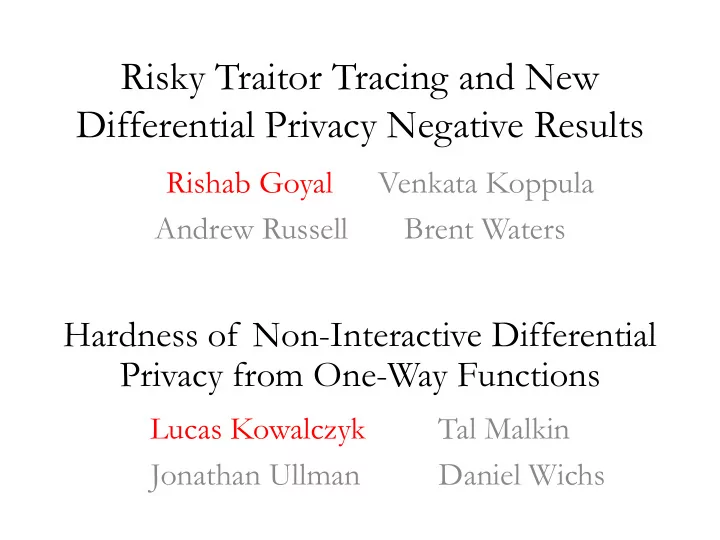

Risky Traitor Tracing and New Differential Privacy Negative Results Rishab Goyal Venkata Koppula Andrew Russell Brent Waters Hardness of Non-Interactive Differential Privacy from One-Way Functions Lucas Kowalczyk Tal Malkin Jonathan Ullman Daniel Wichs
Risky Traitor Tracing and New Differential Privacy Negative Results Differential Privacy Negative Results Rishab Goyal Venkata Koppula Andrew Russell Brent Waters
Traitor Tracing [Chor-Fiat-Naor 94] Find Traitors Decoder Key Challenges: (1) Obfuscated Decoder (2) Collusions 3
Tracing Algorithms 4
(1) No false trace: (2) Catch: 5
It’s About the Ciphertext Size! PKE: Bilinear Maps [Boneh-Sahai-Waters06,Boneh-Waters06…] : Functional Encryption/iO [GGHRSW13,Boneh-Zhandry14] : Can we get better efficiency from standard assumptions if we relax tracing requirement? (* Subsequent to this work, G-Koppula-Waters gave an LWE-based standard TT scheme matching FE/iO-based efficiency.) 6
Relaxing Tracing (1) No false trace: (2) Catch: (1) No false trace: (2) Catch: 7
(Main) Results [G-Koppula-Russell-Waters]
Remaining Talk Part I: Risky Traitor Tracing Part II: Differential Privacy Negative Part II: Differential Privacy Negative Results (Luke) 9
Standalone Risky TT Applications • Persistent decoder setting – Periodic key refreshes, decoder must work across cycles – Catching probability can be amplified • Resource constrained settings – Get best possible tracing w/ 10 KB ciphertext overhead • Risk averse attackers – Deterrence against attackers if traitors heavily penalized – Heavy penalty vs. Low catching probability
Framework for Risky TT – Mixed Bit Matching Encryption 11
Mixed Bit Matching Security Security: 3 properties Distinguish PK/SK CT Hiding CT Hiding Distinguish Distinguish Key Hiding 12
Transformation to Risky TT 13
Transformation to Risky TT 14
Transformation to Risky TT 15
Transformation to Risky TT Check if decoder is correct is correct Do this poly times 16
Transformation to Risky TT Successful decryption probability 17
Missing Pieces and Other Results • Security proof of the transformation – Significantly departs from existing proof techniques for TT • Building Mixed Bit Matching Encryption from Bilinear • Building Mixed Bit Matching Encryption from Bilinear Maps • Generic risky amplification – Improving success probability of tracing 18
Remaining Talk Part I: Building Risky Traitor Tracing Part II: Differential Privacy Negative Part II: Differential Privacy Negative Results (Luke) 19
Recommend
More recommend